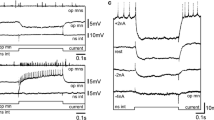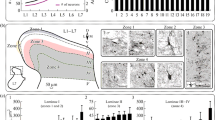Summary
-
1.
On the basis of comparisons between total cell counts and cell counts of cobalt backfills of all roots and connectives leaving the ganglion, we estimate that 38–50% of the approximately 650 neurons in the last abdominal ganglion of the crayfish are local interneurons.
-
2.
The soma size distributions for all of the neurons and for projecting neurons were compared. The comparison indicates that most local neurons are small. All neurons larger than 40 μm (n = 121) have axons that leave the ganglion, while 77 % of neurons smaller than 21 μm (n = 140) are local interneurons (Figs. 1,2).
-
3.
We have recorded and filled with Lucifer yellow 63 local interneurons from which 15 unambiguously different types could be recognized. Five criteria were used in our initial classification. In addition to structure, we noted if each local interneuron was spiking or nonspiking, and, in our most complete experiments, if it was capable of affecting motor activity or projecting interneuron activity when depolarized. We also tried to determine its optimal sensory modality and receptive field.
-
4.
Of the 15 interneuron types we encountered, 5 types (represented by 11 fills) were unilateral, nonspiking, premotor interneurons in the uropod motor circuits (Figs. 3–6).
-
5.
Two types of local premotor interneurons were bilateral and spiking. One excited exopodite motor neurons on one side only. Our evidence suggests that the cells had a nonspiking input region on one side and a spiking output region on the other (Figs. 7–9).
-
6.
Six other types of interneuron were encountered for which we have no evidence of motor effects. All of these neurons had bilateral but asymmetric processes, and were spiking on the putative output side. Some of these neurons appear to be part of sensory processing circuits on the basis of clear modality, distinct receptive field, and short-latency response to sensory input (Figs. 10–12).
-
7.
Two nonspiking, bilateral interneurons were found (Fig. 13). These cells had very large processes which permitted them to be penetrated repeatedly and studied in detail. Although nonspiking, these neurons had separate input and output sides. They are involved in lateral inhibition within the sensory circuits (Reichert et al., submitted).
-
8.
Our results indicate considerable heterogeneity in the properties and functions of local interneurons. Three basic modes of operation were found: (i) five types of interneurons functioned without spikes and may have diffuse input and output; (ii) eight types of bilateral interneurons had properties suggestive of nonspiking input and spiking output sides; and (iii) two bilateral neurons were nonspiking but had distinct input and output sides.
Similar content being viewed by others
References
Altman JS, Bell EM (1973) A rapid method for the demonstration of nerve cell bodies in invertebrate central nervous systems. Brain Res 63:487–489
Bullock TH, Horridge GA (1965) Structure and function in the nervous systems of invertebrates. Freeman, San Francisco, California
Burrows M (1979a) Synaptic potentials effect the release of transmitter from locust nonspiking interneurons. Science 204:81–83
Burrows M (1979b) Graded synaptic interactions between local pre-motor interneurons of the locust. J Neurophysiol 42:1108–1123
Burrows M (1980) The control of sets of motorneurones by local interneurones in the locust. J Physiol (Lond) 298:213–233
Burrows M, Siegler MVS (1976) Transmission without spikes between locust interneurones and motoneurones. Nature 262:222–224
Burrows M, Siegler MVS (1978) Graded synaptic transmission between local interneurones and motor neurones in the metathoracic ganglion of the locust. J Physiol (Lond) 285:231–255
Burrows M, Siegler MVS (1981) Local spiking interneurones and the control of leg movements in the locust. Neurosci Abstr 7:744
Bush BMH (1981) Non-impulsive stretch receptors in crustaceans. In: Roberts A, Bush BMH (eds) Neurones without impulses. Cambridge University Press, Cambridge, England, pp 147–176
Fedosova TV (1978) Neuropile architectonics of the crayfish last abdominal ganglion. Zool Jahrb Abt Anat Ontog Tiere 99:559–584
Harreveld A Van (1936) A physiological solution for fresh water crustaceans. Proc Soc Exp Biol Med 34:428–432
Heitier WJ (1982) Non-spiking stretch-receptors in the crayfish swimmeret system. J Exp Biol 96:355–366
Heitler WJ, Pearson KG (1980) Non-spiking interactions and local interneurones in the central pattern generator of the crayfish swimmeret system. Brain Res 187:206–211
Iles JF, Mulloney B (1971) Procion yellow staining of cockroach motor neurons without the use of microelectrodes. Brain Res 30:397–400
Kandel ER (1976) The cellular basis of behavior. Freeman, San Francisco, California
Kennedy D (1974) Connections among neurons of different types in crustacean nervous systems. In: Schmitt FO, Worden FG (eds) The Neurosciences, Third study program. MIT Press, Cambridge, Massachusetts, pp 379–388
Larimer JL, Kennedy D (1969) Innervation patterns of fast and slow muscle in the uropods of crayfish. J Exp Biol 51:119–133
Mirolli M (1979) The electrical properties of a crustacean sensory dendrite. J Exp Biol 78:1–27
Muller KJ, Scott SA (1981) Transmission at a “direct” electrical connexion mediated by an interneurone in the leech. J Physiol (Lond) 311:565–583
Ogawa F (1939) The nervous system of the earthworm (Pheretima communissima) in different ages. Sci Rep Tohoku Univ 13:395–488
Paul DH (1972) Decrementai conduction over “giant” afferent processes in an arthropod. Science 176:680–682
Pearson KG (1976) Nerve cells without action potentials. In: Fentress JC (ed) Simpler networks and behavior. Sinauer, Sunderland, Massachusetts, pp 99–110
Pitman RM, Tweedle CD, Cohen MJ (1972) Branching of central neurons: intracellular cobalt injection for light and electron microscopy. Science 176:412–414
Popov AV, Markovich AM, Andjan AS (1978) Auditory interneurons in the prothoracic ganglion of the cricket,Gryllus bimaculatus DeGeer. J Comp Physiol 126:183–192
Rakic P (1975) Local circuit neurons. Neurosci Res Prog Bull 13:291–446
Retzius G (1890) Zur Kenntnisse des Nervensystems der Crustaceen. Biol Untersuch NF 1:1–50
Roberts A, Bush BMH (1981) Neurones without impulses. Cambridge University Press, Cambridge, England
Roth RL, Suppes P (1973) Postembryonic addition of neurons to the abdominal nerve cord of the crayfish. Anat Rec 175:430
Shepherd GM (1981) Introduction: the nerve impulse and the nature of nervous function. In: Roberts A, Bush BMH (eds) Neurones without impulses. Cambridge University Press, Cambridge, England, pp 1–27
Siegler MVS (1981a) Posture and history of movement determine membrane potential and synaptic events in nonspiking interneurons and motor neurons of the locust. J Neurophysiol 46:296–309
Siegler MVS (1981b) Postural changes alter synaptic interactions between nonspiking interneurons and motor neurons of the locust. J Neurophysiol 46:310–323
Siegler MVS, Burrows M (1979) The morphology of local nonspiking interneurones in the metathoracic ganglion of the locust. J Comp Neurol 183:121–148
Sigvardt KA, Hagiwara G, Wine JJ (1982) Mechanosensory integration in the crayfish abdominal nervous system: structural and physiological differences between interneurons with single and multiple spike initiating sites. J Comp Physiol 148:143–157
Strausfeld NJ, Obermayer M (1976) Resolution of intraneuronal and transynaptic migration of cobalt in the insect visual and central nervous systems. J Comp Physiol 110:1–12
Takahata M, Nagayama T, Hisada M (1981) Physiological and morphological characterization of anaxonic non-spiking interneurons in the crayfish motor control system. Brain Res 226:309–314
Traub RD, Llinás R (1979) Hippocampal pyramidal cells: significance of dendritic ionic conductances for neuronal function and epileptogenesis. J Neurophysiol 42:476–496
Werblin FS, Dowling JE (1969) Organization of the retina of the mudpuppy,Necturus maculosus. II. Intracellular recording. J Neurophysiol 32:339–355
Wiersma CAG (1957) On the number of nerve cells in a crustacean central nervous system. Acta Physiol Pharmacol Neerl 6:135–142
Wiersma CAG (1958) On the functional connections of single units in the central nervous system of the crayfishProcambarus clarkii (Girard). J Comp Neurol 110:421–471
Wiersma CAG (1961) Reflexes and the central nervous system. In: Waterman TH (ed) Physiology of Crustacea, vol II. Academic Press, New York, pp 241–279
Wiese K (1976) Mechanoreceptors for near-field water displacements in crayfish. J Neurophysiol 39:816–833
Wigglesworth VB (1959) The histology of the nervous system of an insect,Rhodnius prolixus (Hemiptera). II. The central ganglia. Q J Microsc Sci 100:299–313
Wine JJ, Hagiwara G (1977) Crayfish escape behavior. I. The structure of efferent and afferent neurons involved in abdominal extension. J Comp Physiol 121:145–172
Wine JJ, Krasne FB (1982) The cellular organization of crayfish escape behavior. In: Bliss DE (ed) The biology of Crustacea, vol 4. Academic Press, New York, pp 241–292
Wohlers DW, Huber F (1978) Intracellular recording and staining of cricket auditory interneurons (Gryllus campestris L.,Gryllus bimaculatus DeGeer). J Comp Physiol 127:11–28
Author information
Authors and Affiliations
Rights and permissions
About this article
Cite this article
Reichert, H., Plummer, M.R., Hagiwara, G. et al. Local interneurons in the terminal abdominal ganglion of the crayfish. J. Comp. Physiol. 149, 145–162 (1982). https://doi.org/10.1007/BF00619210
Accepted:
Issue Date:
DOI: https://doi.org/10.1007/BF00619210




